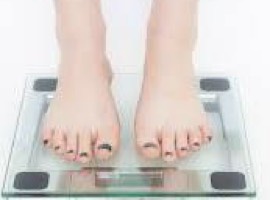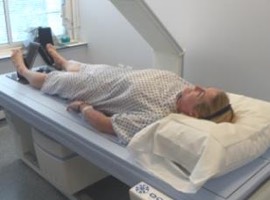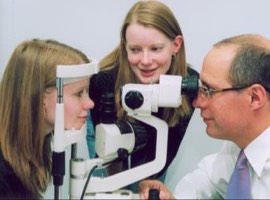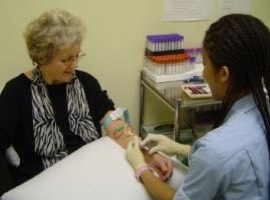About Your Visit
Blood Pressure

Blood pressure is measured a few times during the visit, such as when sitting, standing and lying down. Blood pressure tends to increase with age and can, if too high, lead to cardiovascular problems. Blood pressure is an important indicator of your health and helps us track your well-being over time for research purposes. Our research using blood pressure readings has also revealed new genetic factors associated with blood pressure and which amino acids (building blocks of protein) are good for our heart. If your blood pressure is found to be above 140/90 it is considered to be high (hypertension), and will be highlighted in a report to you and your GP as you may need further assessments.
Height & Weight

Height and weight are measured to assess body size and shape and to calculate Body Mass Index (BMI). For most adults, an ideal BMI is between 18.5 and 24.9. A higher BMI, indicating higher levels of body fat, can be associated with a range of health conditions such as diabetes and heart disease, and tracking BMI over time is important data for our research on healthy ageing. Our research using BMI measurements has identified new genetic factors associated with diabetes, insulin sensitivity and osteoarthritis.
Bone Mineral Density Scan (DXA scan)

A DXA scan of the hip, spine and whole body is an important part of the twin visit. DXA scans measure the amount of calcium and other minerals in bones to give a ‘bone mineral density’ reading. Denser bones have more calcium and minerals and are stronger and less likely to break. The results from the DXA scans have been crucial for the success of our osteoporosis, disc degeneration, obesity and back pain research, resulting in the discovery of new genetic factors associated with osteoporosis and the identification of dietary patterns that are good for our bones.
Clinically useful results from the hip and spine scan will be reported to your GP as an abnormal result could indicate increased risk for fractures and osteoporosis.
Lung Function

The lung function test measures how much air you can blow out from your lungs over a short period of time. This tells us how much air your lungs can hold and about the size of the passages (airways) that carry air to your lungs. We are interested to see how this changes with age and how it differs from one person to the next. We will tell you the results at the visit. People with asthma and other lung conditions have lower readings. Our research using lung function data has revealed that certain vitamins improve lung function, new genes associated with lung function, and the way in which smoking affects lung function.
Physical and Cognitive Fitness Tests

At the twin visit, a combination of (non-strenuous) physical tests such as balance, walking tests and grip strength tests as well as computerised tests and questionnaires will be undertaken to look at health, strength, memory and brain function and how it relates to well-being. Recent results have shown a link between physical health, frailty and our gut microbe, and further studies are being undertaken based on the data being collected to identify factors that may contribute to frailty, to identify people at risk and to find new ways to prevent or reverse it.
Eye Test

Our eye researchers examine eye health and vision by doing a variety of simple tests. These may include measuring the eye pressure and photographing the optic nerve (to look for glaucoma), doing a special scan to see how healthy the retina is (looking for age-related macular degeneration) and measuring how eyes focus (refraction). Using data from eye tests we have discovered that higher dietary intake of vitamin C has been found to have a potentially preventative effect on cataract progression and found new genetic factors associated with short sightedness, eye pressure and dry eye syndrome. We have also discovered a link between certain eye measurements and brain function. The Eye Group’s current research is focused on the genetics of glaucoma, age-related cataract, and myopia. By investigating to what extent these diseases are due to genetic factors, and identifying the genes responsible, the group aims to pave the way for the development of new treatments for some of the main causes of vision loss. At the visit, feedback and advice may be given to you if there are any clinically significant findings.
Blood sample

Your blood sample is a very valuable part of our research. It is separated into different components which are all treated differently. For example, we count the number of red cells, white cell and platelets. We also test your blood to assess your cholesterol and glucose levels and liver function. The cholesterol and glucose results are used in many of our analyses and have helped us identify genetic variants that increase risk of heart disease, diabetes and obesity. All results that are clinically relevant are reported to you and your GP 4-6 weeks after the visit. We also extract DNA and RNA from your blood for analysis which forms the basis of most of our research to identify the genetic and environmental factors associated with disease and ageing. Our genetic and metabolic data is generated using automated methods to generate large amounts of data suitable for our population studies. It is neither suitable nor validated for clinical interpretation on an individual level and for this reason is not released to study participants.
Urine and Stool Sample

Urine and Stool Sample — We use your urine and stool sample in important microbiome research in order to understand how bacteria that live in and on us interact with our health, our immune system and the aging process. We have already discovered that the composition of bacteria differs depending on a person’s genetic make-up and can be associated with fat levels as well – resulting in increased susceptibility to obesity, heart disease and diabetes. We have also shown that the frailer an individual is, the lower the diversity of microbes in their gut. This research continues to demonstrate the importance of a diverse microbiome for our health and a varied diet with lots of fibre. However, despite these results, microbiome research is still a new discipline and we do not yet know the significance of the microbiome data on an individual level. At present, neither we, nor your GP, would be able to interpret microbiome results and for this reason we are not able to provide them.




